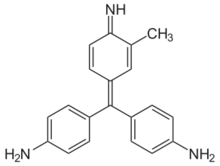Chemistry:Schiff test
| Classification | Colorimetric method |
|---|---|
| Analytes | Aldehydes |
The Schiff test is an early organic chemistry named reaction developed by Hugo Schiff,[1] and is a relatively general chemical test for detection of many organic aldehydes that has also found use in the staining of biological tissues.[2] The Schiff reagent is the reaction product of a dye formulation such as fuchsin and sodium bisulfite; pararosaniline (which lacks an aromatic methyl group) and new fuchsin (which is uniformly mono-methylated ortho to the dye's amine functionalities) are not dye alternatives with comparable detection chemistry.
In its use as a qualitative test for aldehydes, the unknown sample is added to the decolorized Schiff reagent; when aldehyde is present a characteristic magenta color develops. Schiff-type reagents are used for various biological tissue staining methods, e.g. Feulgen stain and periodic acid-Schiff stain. Human skin also contains aldehyde functional groups in the termini of saccharides and so is stained as well.
Mechanism
Fuchsin solutions appear colored due to the visible wavelength absorbance of its central quinoid structure—see also for example viologen —but are "decolorized" upon sulfonation of the dye at its central carbon atom by sulfurous acid or its conjugate base, bisulfite. This reaction disrupts the otherwise favored delocalized extended pi-electron system and resonance in the parent molecule.[3]

The further reaction of the Schiff reagent with aldehydes is complex with several research groups reporting multiple reaction products with model compounds. In the currently accepted mechanism, the pararosaniline and bisulfite combine to yield the "decolorized" adduct with sulfonation at the central carbon as described and shown. The free, uncharged aromatic amine groups then react with the aldehyde being tested to form two aldimine groups; these groups have also been named for their discoverer as Schiff bases (azomethines), with the usual carbinolamine (hemiaminal) intermediate being formed and dehydrated en route to the Schiff base. These electrophilic aldimine groups then react with further bisulfite, and the Ar-NH-CH(R)-SO3− product (and other resonance-stabilized species in equilibrium with the product) give rise to the magenta color of a positive test.[4] Prior formation of classical bisulfite adducts of the tested aldehyde may, when the adducts are stable, give rise to false negative tests such as in the case of testing for the aldehydic terminus of glucose.[4] Schiff's reagent on reaction with Acetaldehyde gives pink colour.
Such an imine-mediated mechanism was first proposed by Paul Rumpf (1908–1999) in 1935,[5] and experimental evidence was provided by Hardonk and van Duijn in 1964.[6] In 1980, Robins, Abrams and Pincock provided substantial NMR evidence for the mechanism, leading to its general acceptance.[7] Stoward had examined the mechanism in 1966 and, on the whole, considered this mechanism to be correct.[8]
A second, earlier mechanism continues to appear in the literature.[9] The mechanism was proposed in 1921 by the eminent German organic chemist Heinrich Wieland and his student Georg Scheuing (1895–1949).[10][11] Bisulphite was believed to react with the available aromatic amine functional groups to form N-sulfinic acid groups, Ar-NH-SO2H, followed by reaction with aldehyde to form sulfonamides, Ar-NH-SO2CH(OH)-R. The 1980 NMR data that allowed visualization of intermediates does not support this mechanism or the sulfonamides as the chromogenic product.[7]
See also
- Tollens' reagent
- Fehling's reagent
- 2,4-Dinitrophenylhydrazine
- Fehling's solution
- Barfoed's test
- Benedict's reagent
References
- ↑ See:
- Schiff, Hugo (1866) "Eine neue Reihe organischer Diaminen. Zeite Abteilung." (A new series of organic diamines. Second part.), Justus Liebigs Annalen der Chemie, 140 : 92–137. [in German] From p. 132: "Das Rosanilinsulfit verbindet sich nicht direct mit den Aldehyden. Schüttelt man die rothe Lösung des krystallisirten neutralen Sulfits oder auch die nach obiger Weise bereitete leukanilinhaltige gelbe Lösung mit irgend einem flüssigen Aldehyd, so erhält man sogleich eine rothe Lösung, und diese Farbe verwandelt sich allmählich in ein je nach dem angewandten Aldehyd helleres oder dunkleres Violettblau." (Rosaniline [i.e., fuchsine] sulfite does not combine directly with aldehydes. If one shakes, with any liquid aldehyde, a red solution of the crystallized neutral sulfite [of fuchsine] or even the yellow solution which was prepared in the above-mentioned way and which contains leukaniline [i.e., fuchsine treated with aqueous sulfurous acid], then one obtains at once a red solution, and this color is transformed into a lighter or darker violet blue, depending on the aldehyde that's used.)
- See also: Schiff, Ugo (1866) "Sopra una nova serie di basi organiche" (On a new series of organic bases), Giornale di scienze naturali ed economiche, 2 : 201–257. [in Italian] From p. 253: "Il solfito di rosanilina non si combina direttamente colle aldeidi. Quando si agita una soluzione solforosa di idrato o di acetato di rosanilina con un'aldeide qualunque, allora la soluzione gialla ássume subito un colore rosso che poco a poco si trasforma in un bel violetto più or meno intenso a secondo l'aldeide applicata." (Rosaniline sulphite does not combine directly with aldehydes. When a sulfurous solution of rosaniline hydrate or rosaniline acetate is shaken with any aldehyde, then the yellow solution immediately becomes a red color that little by little transforms into a fine violet, [which is] more or less intense according to the aldehyde [that's] used.)
- See also: Schiff, Hugo (1867) "Dérivés de la rosaniline" (Derivatives of rosanaline [i.e., fuchsine]), Comptes rendus, 64 : 182–184. [in French] From p. 182: " … si l'on agite une solution sulfureuse diluée, soit de sulfite, soit de tout autre sel de rosaniline, avec quelques gouttes d'un aldéhyde, alors il se dégage de l'acide sulfureux, la solution se colore d'abord en rouge, puis en violet, et peu à peu il se forme un précipité constitué de petites écailles cristallines d'un violet cuivré." ( … if one shakes a dilute sulfurous solution either of the sulphite or any other salt of rosaniline [i.e., fuchsine] with a few drops of an aldehyde, then sulphurous acid is evolved; the solution is first colored red, then violet, and gradually a precipitate is formed consisting of small crystalline flakes of a coppery violet.)
- ↑ Histology, cell and tissue biology 5th Ed., 1983 ISBN 0-333-35406-0
- ↑ Juan Carlos Stockert, Alfonso Blázquez-Castro (2017). Fluorescence Microscopy in Life Sciences. Bentham Science Publishers. ISBN 978-1-68108-519-7. https://ebooks.benthamscience.com/book/9781681085180/. Retrieved 17 December 2017.
- ↑ 4.0 4.1 "Schiffsche Probe" (Schiff test), University of Bayreuth, Bavaria, Germany, accessed 8 March 2013. [in German]
- ↑ Rumpf, P. (1935) "Recherches physico-chimiques sur la réaction colorée des aldéhydes dite “réaction de Schiff” " (Physical-chemical investigations of the color reaction of aldehydes, called the "Schiff reaction"), Annales de Chimie, 11th series, 3 : 327–442. [in French]
- ↑ Hardonk, M.J. & Van Duijn, P. (1964) "The mechanism of the Schiff reaction as studied with histochemical model systems," Journal of Histochemistry & Cytochemistry, 12 (10) : 748–751.
- ↑ 7.0 7.1 Robins, J.H., Abrams, G.D. & Pincock, J.A. (1980) "The structure of Schiff reagent aldehyde adducts and the mechanism of the Schiff reaction as determined by nuclear magnetic resonance spectroscopy," Canadian Journal of Chemistry, 58 (4) : 339–347.
- ↑ Stoward, P.J. (1966) "Some comments on the mechanism of the Schiff reaction," Journal of Histochemistry & Cytochemistry, 14 (9) : 681–683.
- ↑ Histochemistry, theoretical and applied 4th Ed. 1985 ISBN 0-443-02997-0 Note: the depiction of the sulfonic acid mechanism in this edition contains an error as the aldehyde R group is bonded to nitrogen and not to its carbon neighbor
- ↑ Wieland, Heinrich ; Scheuing, Georg (1921) "Die Fuchsin-schweflige Säure und ihre Farbreaktion mit Aldehyden" (Fuchsine-sulfurous acid and its colored reaction with aldehydes), Berichte der deutschen chemischen Gesellschaft, 54 (10) : 2527–2555. [in German]
- ↑ Puchtler, Holde; Meloan, Susan N.; Brewton, Barbara R. (1975) "On the history of basic fuchsin and aldehyde-Schiff reactions from 1862 to 1935," Histochemistry, 41 (3) : 185–194.
External links
 |

